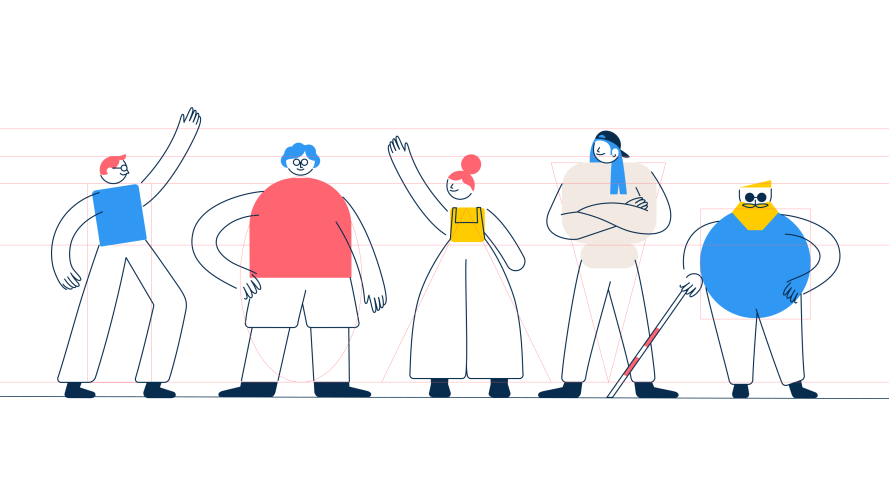
ILLUSTRATION
COPYWRITING
DIVERSITY
Inclusive Communication: Bias-Free Copywriting and Illustration
Can you write inclusively in Spanish even if you don't use the “e” or “x” endings yet? How do you illustrate without falling into gender stereotypes? Today we’ll sharing some tips that we’ve been using in order to communicate in the most inclusive way possible, reach the largest number of people and be consistent between what we think and what we say.
We define ourselves as a "human-centered" agency, but that term is everywhere these days, so we want to be sure that we are working to honor it. From saying to doing... that's where we’re trying to go. But why is using an inclusive mode of communication important for a company, anyway? On the one hand, it shows your position. The “washed up” companies who don’t want to reveal their ideologies are a thing of the past. The organizations of the future have a voice, and our voice is always on the side of inclusion, well-being and diversity.
We believe that having diverse voices within the agency enriches our work, and we also believe that it makes sense to adjust our voice as a company according to what we stand for. In addition, from a strategic vision, speaking to the largest number of audiences amplifies our message, and that’s always a good communication practice.
Inclusive Copywriting
We recently released an instagram post about inclusive copy. It’s a very popular topic so we expected a good response, but we were surprised by the flood of comments and interaction it had.
We believe that it happened because instead of laying down the law, we came from a place of "not perfect, but possible," a position that challenges and defines us as a company.
At Indicius we are bilingual, and English itself is much more neutral. But in Spanish we still haven’t 100% incorporated inclusive language, using “e” and “x” endings on gendered words rather than defaulting to the masculine, “o”. This happens because quite a few of us are +30, and although we are super on board with learning new ways, it still doesn't come as naturally for us. In addition, when working for different clients, we have to adapt to their communication tones.
Still, we want everyone who reads our content to feel included, and we don't think there's just one way to do that. So, in this journey to be better every day, we’re finding ways to stop defaulting to the masculine when writing in Spanish, even without using the “e” or “x” endings, which can still be difficult to incorporate in a corporate setting.
Some tips
Take advantage of the pronoun “quien”: “Los colaboradores” can be translated to “quienes colaboran”. “Los participantes”, to “quienes participan”
We can also use adjectives or nouns without gender, for example:
“Todos” —> “Todas las personas”
“Los alumnos” —> “el alumnado”
“Muchos” —> “un gran número de”
Another very good tip is to use prepositional phrases to replace masculine adjectives:
“Interesados” —> “con interés en”
“Desempleados” —> “sin empleo”
“Observados” —> “Bajo observación”
Illustration without biases
Since everything we do is a way of communicating, today I also want to talk about illustrations (which we love and, if I do say so myself, we do very well).
Sometimes we take some things for granted or minimize others and end up falling into simplifications or biases based on gender, race or social class.
Something I’ve learned in my work is that to improve processes, it can be beneficial to work with questions that get us thinking. I got the idea from “Publicitarias”, who have awesome resources to rethink campaigns and ways of working, and even have card decks with questions to facilitate self-assessment.
Questioning ourselves is a good way to reflect and dialogue with our own prejudices.
Some questions to answer after an illustration process
If I have to illustrate only one character, do I usually think of a male one?
If I have to illustrate a man, do I usually use colors like light blue/blue/green, short hair, certain clothes and body type?
Vice versa: If I illustrate women, do I usually use pink/red/violet, long hair, skirts/dresses?
If I have to illustrate a family, do I always think of the hetero-normative family made up of mom/dad + son/daughter?
If I have to illustrate certain tasks, do I resort to gender stereotypes? Example: Shopping/ women. Sports / men.
And after asking ourselves these questions, if we answered yes to one or more, I'll give you a tip that has been magical for me (in many areas of life): The key is to ADD, not subtract.
Here imagine my uncle Cacho saying “Hey, what’s this all about? Is it wrong if a woman wants to wear a skirt?"
No, Uncle. It's not wrong, how could it be? It’s just not the only right way.
Here are some tips
If you illustrate several characters, think about having a variety of representations
The hetero-normative family is just as valid as one with two mothers, or one without children (or with cat children)
You can always think of characters without gender or fantasy characters
A boy with short hair can be accompanied by one with long hair and colored nails
A woman with long hair and the pink dress is just one type of woman, just as valid as one who wears pants
Try not to associate genders with particular colors or activities
Try not to use accessories for only one gender
If you’re going to illustrate a situation where someone is buying or consuming something, try not to fall into stereotypes of gender, race or social class
The magic is in the variety!
Did we miss any tips? What do you think of all this?
If you made it this far, thanks for reading, and we would love to see you on our social media to hear your opinion.


